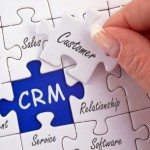Six Tips to Select the Right CRM System
by Chris Fritsch, Client Success Consultant
 Research estimates that up to 70% of CRM systems fail to meet expectations – and a failed CRM implementation can be extremely costly, not just in terms of the financial expense, but also because of the costs in lost time – and credibility. Even more impactful: you don’t often get a second chance at CRM success. This means that it’s critical to select the right CRM system.
Research estimates that up to 70% of CRM systems fail to meet expectations – and a failed CRM implementation can be extremely costly, not just in terms of the financial expense, but also because of the costs in lost time – and credibility. Even more impactful: you don’t often get a second chance at CRM success. This means that it’s critical to select the right CRM system.
The good news is, CRM success is possible. If you simply follow a few critical steps before and during the CRM selection process, you can ensure that you select a system that will help you achieve your organization’s goals, enhance adoption and provide value to your users and return on your investment.
Tip 1: Problems First, Then Products
When attempting to successfully select and implement CRM software, it’s essential to focus on people and processes first, products second. Too many people immediately rush out to find potential vendors so they can set up demonstrations of the most popular CRM software. While it’s easy to get caught up in the shiny bells and whistles of a good CRM demo, it’s important to resist the temptation to dive into features and functions too soon without first taking the time to gain a real understanding of your organizational and user needs.
Tip 2: Assess Your Needs
Organizations buy CRM software for a number of reasons – but each firm is unique. To provide real value and ROI, before making the purchase, you have to understand what you are trying to accomplish. Start by putting together a list of the key reasons you think you need a CRM. Are you trying to communicate more effectively with Clients and prospects? Manage and evaluate the ROI of events or sponsorships? Track and enhance business development efforts? Help the organization be more efficient? Maybe increase business and revenue?
After assessing your organization’s needs, you may discover that you have a lot more goals than you first thought. If this is the case, it will be important to prioritize the goals. Don’t try to boil the ocean. If you try to tackle too many things at once, especially during the initial rollout, you will be less likely to succeed. Instead, assign your goals to a timeline based on importance and value to users. For the initial implementation, set a few relevant goals, achieve those initial successes, communicate the successes – and repeat.
Once you understand your organization’s unique needs and requirements, it’s time to talk to your users. One of the biggest frustrations we hear from Clients is a lack of CRM adoption. This isn’t surprising since, in many of these organizations, system users were not involved during the selection process. To get people to buy in and use software, it has to provide value not only to the organization, but to them individually. The challenge is that different people define value differently, which means different groups or types of users will have their own unique needs and requirements. That’s why it’s so important to get them involved early. Making your users part of the process up front will also make them more likely to adopt the software later.
To gather user input, consider creating focus groups to provide feedback on product features and functions. You may even want to meet with some of the naysayers individually to start encouraging their participation and head off future roadblocks. Finally, be sure to involve key stakeholders in system demonstrations to help evaluate the software and solicit their feedback before proceeding on system selection. In fact, it’s beneficial to have users involved throughout the rollout to give you ideas on how to improve the CRM implementation for everyone.
Tip 3: Evaluate the Systems and Providers
After gathering all of the relevant information, it’s important to fully document your requirements and make sure you are well-prepared before reaching out to providers. The best way to do this is with what I call a ‘demo roadmap.’ This is a comprehensive two- to three-page document that sets out all of the details for the demonstrations along with all the needs and requirements gathered during the needs assessment and the features and functionality that you want to see. Your ‘roadmap’ will guide the CRM providers so that they show you the key system attributes that are critical to the success of your organization and users and also helps to prevent the demonstrations from becoming a ‘dog and pony show.’ Your roadmap should be shared with the CRM providers well in advance of the demonstrations to give them time to adequately prepare.
Some larger organizations may also find it beneficial to take an additional step and create a much more detailed formal RFP document. This request for proposals would be sent to potential CRM providers to solicit answers to a number of questions before scheduling any demos. The formal responses allow you to evaluate and compare the vendors and their system features and pricing in advance of the demonstrations. Many organizations use the RFP to limit the demonstrations to only the potential providers who are able to meet the firm’s budget and requirements.
In our next post, we will focus on steps to guide the vetting process and help you select the right CRM system for your organization…
– At CLIENTSFirst, we have helped hundreds of firms successfully select and implement CRM systems. Feel free to reach out to us. We are always happy to share information, best practices and resources for CRM success.





Write a comment: